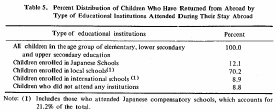| Home > Policy > White Paper, Notice, Announcement > White Paper > EDUCATIONAL STANDARDS IN JAPAN 1971 > CHAPTER |
||
With the recent increase in the number of overseas residents, the education of their children has become a significant problem. In 1969, it was estimated that approximately 8,000 school age children would be living overseas for more than one year.
Educational opportunities for Japanese children overseas are provided either in full-time Japanese schools which have been set up in twenty-three cities, mainly in Asia, Africa and South America, or in Japanese compensatory schools which offer education, especially Japanese language education, on Saturdays and Sundays to those who are enrolled in local or international schools.

Note: (l) Includes those who attended Japanese compensatory schools. Which accounts for2I.2% of the total.
Children who attended Japanese schools have no special problems upon retuning to Japan, because the educational programs at these schools are based on the Japanese course of study and are subsidized by the Japanese government. However, it is difficult for most of those children Who attended local or intaternational schools to adjust to schools in Japan due to the difference in customs and educational contents. In addition, public schools in Japan often place children who have returned from overseas in grades lower than usual because of their lack of ability in the Japanese language. There is also a problem in that boarding schools are too few to enroll children who could otherwise be left at home in Japan.
Therefore, it is necessary to provide an education similar to that in Japan by taking such measures as improving and strengthening Japanese schools and Japanese compensatory schools abroad, and developing correspondence education. It is also necessary to investigate the educational content, method and systems specifically designed for children who have returned from abroad, and to consider fully measures for children who have to be left behind in Japan so that educational opportunities may be guaranteed to these children. Other major countries also have schools overseas which conduct education on the basis of standards prescribed within their own countries. The United Kingdom31so has a sufficient number of residential schools within the country and therefore many children are left at home; in France, correspondence education is con-ducted for those children who live in countries lacking French schools. In many major countries, promotional measures, such as the payment of salaries of those who teach at schools overseas, or facilities and equipment subsidies are being taken.
| Back to Top | MEXT HOME |